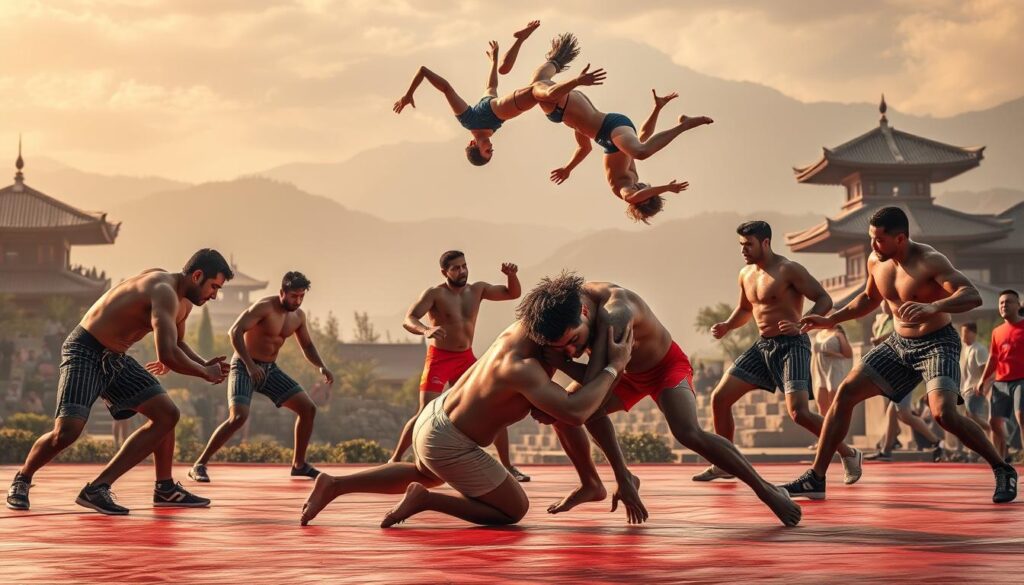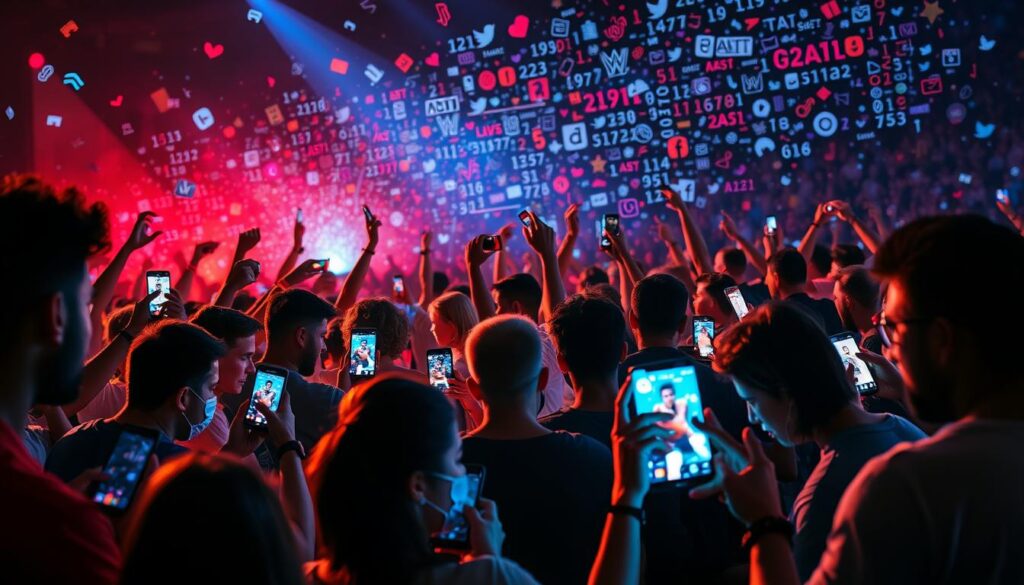Imagine a Minnesota teen wearing a lucha libre mask to school on Halloween. This tradition comes from Mexican wrestling’s colorful shows. Now picture a Tokyo dojo where MMA fighters practice puroresu moves, inspired by Antonio Inoki. This isn’t just a dream. It’s a regular Tuesday.
Pro wrestling’s magic lies in its ability to blend cultures and stories. The WWE Universe is like a sports league and a traveling theater. It turns Stone Cold Steve Austin’s famous theme into beats from Lagos clubs. Bulgarian teens analyze Roman Reigns’ heel turns like they’re studying Shakespeare.
Remember when studying soap operas seemed pointless? Now, we see how wrestling’s world works. It’s all about keeping the story alive, thanks to kayfabe.
In Mexico, fans throw trash at the bad guys, while in Japan, they cheer for skill. It’s not just about believing in the story. It’s about creating a shared myth together, across languages.
Wrestling takes on local flavors everywhere, from Montreal to Mumbai. The real magic happens when you find wrestling fans in unexpected places. Like your Bulgarian Uber driver quoting Dusty Rhodes. Are you ready to explore wrestling’s cultural side?
History of International Audiences
Before memes and viral tweets, wrestling fans spread the sport through bootleg tapes and secret networks. Imagine the 1980s, where fans traded VHS copies of NJPW matches like they were rare Pokémon cards. These tapes were passed around, showing grainy footage of wrestling.
These fans weren’t just watching—they were smuggling wrestling culture. They learned about lucha libre masks and British catch wrestling holds. It was like they were studying lost tribes.
Sam Ford’s work shows how wrestling styles became global treasures because of fan obsession. El Santo, a Mexican wrestler, became a star in 52 films. His silver mask made lucha libre a national religion in Mexico, even bigger than Sunday mass.
Billy Riley’s “Snake Pit” gym in Wigan was like a secret society for wrestling. It sent catch wrestling missionaries all over the world.
Let’s look at some numbers:
- Over 10 million VHS tapes were shared worldwide before 1990 (Harrington’s research)
- El Santo’s 1952 match drew 25,000+ spectators in Mexico City, the biggest crowd ever
- 80% of 1980s Japanese wrestling fans discovered US stars through third-generation tape copies
This wasn’t cultural imperialism—it was collaborative rebellion. When Texas wrestlers adopted Mexican técnico/rudo dynamics, and Japanese promotions mixed strong style with American flair, they created new genres. No single nation could claim them. The real victory? Showing that shared spectacle can cross borders without needing Twitter.
How Styles Connect with Regions
If wrestling styles were cocktails, each region would have its own special mix. This mix is made with history, local flavor, and cultural identity. Let’s explore why German matches are like chess and Indian wrestlers are like Bollywood heroes. It’s not just about what they wear.

Germany’s focus on technical matwork comes from their engineering background. Their wrestling shows how they adapt precision into human form. In Mexico, CMLL has ruled for 90 years, making lucha libre a generational heirloom like grandma’s secret salsa.
Now, let’s travel the world through wrestling’s colorful lens:
| Region | Style | Cultural Roots | Signature Move |
|---|---|---|---|
| Mongolia | Bökh-inspired power | Nomadic warrior tradition | Sky-high suplexes |
| India | Acrobatic spectacle | Bollywood theatrics | 360° rope flips |
| Tennessee | Moonsaulting hillbillies | Appalachian showmanship | Barn-door splashes |
The big surprise? Antonio Inoki’s 1976 “fight” against Muhammad Ali. This odd mix of wrestling and boxing started MMA. It’s like Shakespeare inventing rap by accident.
From Tokyo to Tennessee, wrestling takes on local traits like a sponge. Whether it’s Mongolian throat singers or Mexican luchadores, wrestling shows it’s a universal language with many dialects.
The Growth of Lucha Libre and Puroresu Globally
Masked luchadores and Japanese strong style wrestlers have become huge hits worldwide. They’ve changed how fans watch wrestling, fast. NJPW’s Wrestle Kingdom now draws more fans than Coachella, with over 40,000 attending each year. AAA’s U.S. shows are a big hit, creating a mask economy that’s booming.
Lucha libre has grown into a $50M/year industry. Wrestlers’ masks are seen as valuable assets, like gold. When Mil Máscaras first appeared in WWF in 1972, fans were amazed by his colorful mask. Today, Rey Fénix’s masks sell out quickly, just like Supreme’s limited-edition hoodies.
Puroresu has also made a big impact. UFC fighters now use strong style moves in their training. These include elbow strikes and suplexes, thanks to legends like Shinya Hashimoto. It’s a mix of violence and art.
- Wrestle Kingdom’s 2023 attendance: 42,011 (Tokyo Dome)
- AAA’s 2024 U.S. events: 12-city tour, 90% average capacity
- Lucha mask auctions: $8,200 record sale for original Dr. Wagner Jr. design
AEW’s partnership with Japan’s DDT Pro has brought comedy to wrestling. They’re known for “wrestling with otters” matches. This mix of absurdity has fans laughing and learning.
This wrestling expansion is about growth, not copying. Lucha’s aerial moves and puroresu’s hard-hitting style are blending. This creates a new language of wrestling, where everyone can understand the action.
WWE, NJPW, CMLL Expansion
WWE made $275.3 million in 2023 Q2 from international sales. That’s a lot of money, enough to make Mickey Mouse jealous. But it’s not just about the money. It’s about geopolitics and wrestling.
Vince McMahon’s WWE is building arenas in Riyadh. At the same time, Mexico’s CMLL is sneaking Cuban talent into the country. It’s like Disney buying UN ambassadors, but with wrestling.
New Japan Pro-Wrestling (NJPW) has a different approach. They have an English commentary team, including a reformed Bullet Club member. They make “Strong Style” exciting for fans worldwide, keeping the samurai spirit alive.
WWE is broadcasting in Hindi, making The Rock known as “Pathar Ka Sher” in Mumbai. It’s not just dubbing; it’s corporate magic. Kayfabe is more important than ever, as WWE creates new characters fast.
Let’s compare how these companies grow:
| WWE | CMLL | NJPW | |
|---|---|---|---|
| Expansion Fuel | Petrodollars | Defector Talent | Streaming Subs |
| Cultural Bridge | Localized Stars | Lucha Heritage | Bilingual Commentary |
| 2023 Growth | +18% Mideast | +9 New Cubans | 47% Int’l Subs |
Today’s wrestling is not like your grandpa’s. It’s a global battle, with WWE and CMLL fighting for talent. Kayfabe is key, as believing in Jinder Mahal as Punjab’s hero sells well in Chandigarh.
The ring ropes now show cultural divides. Every move is a diplomatic statement. Welcome to wrestling’s new world, where reality is rewritten.
Fan Subcultures: UK, Mexico, Japan, India, etc.
What do a masked luchador and a Delhi office worker have in common? More than you might think. Wrestling fandom is not just imported; it’s culturally adapted and remixed. Fans around the world are rewriting the rules.
In Mexico City, lucha libre is more than entertainment; it’s a sacred ritual. Fans celebrate weddings with masked officiants and high-flying moves. In Japan, Stardom fans show off their gothic Lolita style outside Tokyo Dome. It’s a mix of cosplay and combat.
The numbers show the impact:
| Region | Subculture Quirk | Impact Metric |
|---|---|---|
| UK | Progress Wrestling’s punk ethos | 2,500+ weekly attendees |
| India | DIY mats in Delhi basements | 4.3M WWE viewers monthly |
| Japan | Kawaii deathmatch accessories | 87% merch sales growth |
In Bradford, TikTok creators bring back World of Sport with #BrawlChain challenges. It’s a mix of wrestling and dance. One 19-year-old said, “It’s not about being British Strong Style,” “It’s about making Strong Style British.”
India’s wrestling scene is full of contrasts. WWE is big on TV, but underground rings are growing. Fans are creating their own wrestling world, mixing local heroes with WWE stars.
Mexico’s lucha libre weddings show the power of fandom. The bride’s veil matches Rey Mysterio’s mask. The cake topper is a tiny Mil Máscaras doing a plancha. That’s cultural adaptation at its finest.
Social Media’s Role in Global Engagement
When @FinnBalor’s Twitter feed turns RAW plotlines into interactive stories, kayfabe is thriving. WWE’s 152 million social media followers are not just watching; they’re part of a global story. This story blends backstage drama with Instagram Stories and TikTok duets.
Spanish-language WWE accounts are masters of this mix. Seth Rollins’ rants become telenovela-worthy betrayals in Mexico. Fans debate if Rollins’ latest outburst deserves a Netflix spinoff.
Three ways social media changes global fandom:
- Democratized storytelling: Dominik Mysterio’s Twitter outburst sparks rival hashtag campaigns in Mexico and India
- Platform-specific kayfabe: Instagram carousels dissect faction politics, while YouTube Shorts turn botched moves into comedy
- Real-time localization: Brazil’s WWE account drops Portuguese roast videos during PPVs, blending wrestling lore with humor
| Platform | Strategy | Global Impact |
|---|---|---|
| Twitter/X | Threaded kayfabe extensions | +37% int’l engagement (2023) |
| Visual storytelling arcs | 62M non-English followers | |
| TikTok | Regional challenge campaigns | #WWEIndia trends 19x monthly |
| YouTube | Localized post-show analysis | 45% watch time from EMEA/APAC |
This isn’t just content—it’s digital territory wars. Japan’s NJPW fans flood Twitter with GIFs of Okada’s Rainmaker during WWE events. They’re not trolling; they’re asserting cultural ownership over their version of pro wrestling.
WWE’s social teams know today’s fans want to live the storyline, not just watch it. Rhea Ripley’s Instagram poll “decides” her next feud, engaging fans worldwide. It’s kayfabe 3.0—a global choose-your-own-adventure where every retweet is a vote for wrestling’s future.
Translation & Localization
Ever tried explaining Stone Cold Steve Austin’s beer-chugging rage to someone from a culture where drinking in public is a big no-no? That’s what wrestling localization is all about. It’s not just about translating words. It’s about changing whole stories to fit different cultures.
Take CMLL’s Día de Muertos spectaculars for example. While American wrestling might just add skeleton makeup, Mexico’s top league weaves in real traditions. Last year, a luchador talked to dead legends through masks. This would confuse some fans but thrill others.
The real magic is in the translation. WWE’s Mandarin commentators make sure heel promos are not too harsh. They change “I’ll kill you” to “I’ll embarrass you.” It’s all about cultural translation at its best. Japanese fans also get special backstories for wrestlers, fitting their storytelling style.
- WWE’s German dub uses local dialects: Bavarian for friendly faces, Berlinerisch for cool villains
- NJPW’s English merch site sells “Strong Style” t-shirts with Osaka designs
- AEW’s Spanish broadcasts add lucharesu terms to their matches
Behind every suplex is a team of cultural experts working hard. They make sure everything fits the local culture. From colors to gestures, they make sure Roman Reigns’ moves are just as powerful everywhere.
This careful balancing act is why wrestling fans all over the world keep growing. The next time you hear a catchphrase that feels just right, remember. It’s not just translation. It’s making something special for everyone.
Conclusion
Wrestling fandom has changed how we see cultural exchange. Fans in Belfast watch NJPW’s Wrestle Kingdom in basements. In Buenos Aires, street vendors sell CMLL masks. It’s like a global community, as described by Goggin and Emmanouloudis.
In Mumbai, people cheer for Roman Reigns while eating samosas during WWE Raw. This shows how wrestling brings people together worldwide.
This growth of wrestling is full of paradoxes. Mexican luchadores inspire German techno remixes. Japanese strong style influences Brooklyn indie music.
Streaming algorithms now reach fans in Iowa and Seoul. Social media has turned live chants into TikTok captions for backyard stunts.
The future of wrestling might include AI tailoring promos for specific audiences. Imagine Triple H’s promos with Delhi’s political twists or Bloodline storylines for São Paulo’s crime rates.
But wrestling’s true magic lies in its physicality. Bodies flying through the air connect fans across languages. Every suplex holds the essence of Sumo, Mexico’s mystique, and America’s spectacle.
WWE’s deals in Saudi Arabia and NJPW’s LA dojos show wrestling’s global reach. Streaming platforms erase borders, making wrestling a global village. It balances tradition and viral trends.
The real power of wrestling is making a Tokyo fan’s “Kazu!” feel familiar in Minneapolis. What other stage can unite national identities through pop poetry every night?

